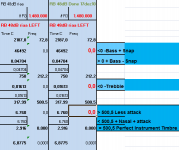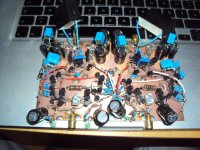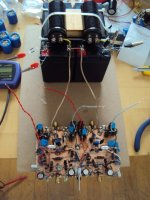Well here I go again.... I have built many riaa amps based on a "central" passive filter.
Inittially I did not care much to the precision of the parts values I used... and I got many different results.. no concistency... Some presented very good and deep bass but lacked attack and treble insight... other times I got imense spatiality with great detail in the highs but lacked the full bodied sound.
I experiented a lot with the extremes and was never convinced... than I read Stanley´s work and made some calc and found that we can play with extremes as long as the mid point is very well defined.
IMO the 500.5 Hz inflection poin is the most important because if defines instrument timbre.
Please have a look at the comments I wrote two years ago....
Inittially I did not care much to the precision of the parts values I used... and I got many different results.. no concistency... Some presented very good and deep bass but lacked attack and treble insight... other times I got imense spatiality with great detail in the highs but lacked the full bodied sound.
I experiented a lot with the extremes and was never convinced... than I read Stanley´s work and made some calc and found that we can play with extremes as long as the mid point is very well defined.
IMO the 500.5 Hz inflection poin is the most important because if defines instrument timbre.
Please have a look at the comments I wrote two years ago....
Attachments
When I started this issue you told me the correct calc should be here: http://www.diyaudio.com/forums/analogue-source/154210-mpp-299.html#post2765470
In your pdf I did not find a direct relation between 0.0408 x 7500r and these are the items responsible by the 500.5Hz point, so I made a spreadsheet for this build in search of a relative correspondence. I found a good compromise that only works if output mirror imp is 305700r, using the values you predicted for the components.
I need to reach a good base, because I do not have the parts Miib used (I only have 4700pF, 3700pF and 2200pF caps to jugle with) so I will need to trim.
I am not trying to modd this build, I am trying to understand how it works and why it is so different from everything else.
In your pdf I did not find a direct relation between 0.0408 x 7500r and these are the items responsible by the 500.5Hz point, so I made a spreadsheet for this build in search of a relative correspondence. I found a good compromise that only works if output mirror imp is 305700r, using the values you predicted for the components.
I need to reach a good base, because I do not have the parts Miib used (I only have 4700pF, 3700pF and 2200pF caps to jugle with) so I will need to trim.
I am not trying to modd this build, I am trying to understand how it works and why it is so different from everything else.
MiiB derived the RIIA components by Laplace in LT Spice so he is responsible for the component values. Another desire was that we use standard parts that preferably are available in 1% so that a builder without measurement equipment lands in the ballpark.
To test RIAAs i use the square wave method either with a very high precision, high zero passive anti RIAA or with Burghard Vogels active anti RIAA that has an even higher pole.
I measure also level, anti RIAA in place with a precision, calibrated Wandel&Goltermann true RMS meter. Ricardo, this is an illusion anyway. For example drive your phono a bit harder and you will see that you run very fast into slew limit and then the nice square is gone. Also when you measure level with sine and square for comparison, even using a true RMS meter you will see differences, so dynamically the precision of the RIAA shifts.
I have worked very hard over the last 3 years, much documented on this thread, to minimize dynamic shifting time response. For example take the Gm of the Paradise.
It starts with a gigantic 2000mS that is degenerated to aprox. 1400mS. That is 10 times higher the 8 x 2SK170 in parallel. Then take the rather high 48V supply, then ........
You see, your calculations are static. I trust your listening but only in the exact circumstances you had at your session.
To test RIAAs i use the square wave method either with a very high precision, high zero passive anti RIAA or with Burghard Vogels active anti RIAA that has an even higher pole.
I measure also level, anti RIAA in place with a precision, calibrated Wandel&Goltermann true RMS meter. Ricardo, this is an illusion anyway. For example drive your phono a bit harder and you will see that you run very fast into slew limit and then the nice square is gone. Also when you measure level with sine and square for comparison, even using a true RMS meter you will see differences, so dynamically the precision of the RIAA shifts.
I have worked very hard over the last 3 years, much documented on this thread, to minimize dynamic shifting time response. For example take the Gm of the Paradise.
It starts with a gigantic 2000mS that is degenerated to aprox. 1400mS. That is 10 times higher the 8 x 2SK170 in parallel. Then take the rather high 48V supply, then ........
You see, your calculations are static. I trust your listening but only in the exact circumstances you had at your session.
This is the ancestor of the Paradise. It is very similar in concept so the principle has being proven to work a long time ago. Gm stage, mirror, transimpedance RIAA and finally the buffer.
When i look at it i must smile. A lot has happened since but the idea is basically the same. I will fit some improvements and then listen to it hopefully today.
When i look at it i must smile. A lot has happened since but the idea is basically the same. I will fit some improvements and then listen to it hopefully today.
Attachments
The Ancestor is playing. I modified it according to the idea we developed for the Starless.
I took out the big coupling cap after the buffer and put a much smaller 49nF Styroflex before the buffer. I made the buffer to have 2MOhm input impedance so the resistor in the bass is now down to 90,7KOhm from 95kOhm so i expected a small loss in the bass. So it was and i had to crank my subwoofer a little. I will restore the original value later but it was time to listen first. The sound i got is silky smooth. I even had to readjust the VTA to the old value to get a neutral balance. That comes partly from the cacoded Fet input stage and partly from the transimpedance principle in my experience. It is not as iron fisted, tight and sparkling then the one stage NFB RIAA but there is a certain liquidity and "freedom" i appreciate. Sibilance is now less too. That comes in part from the one stage
parallel feedback concept of the single stage NFB RIAA. That creates a pole over 20kHz and can enhance detail. It is not that drastic as the infamous Neumann pole and can be 100% canceled by a passive pole at the output ( Self, Vogel et.all.). I will add that pole and try it again later. Concerning offset after adjustment ( in this case the source resistors on the input Fets ) i got around plus-minus 1V floating over the RIAA. I think this is quite good considering that the mirror i use here has a much higher output impedance then the one we use in the Paradise by "mirroring the mirror" and returning the base currents differentially. This is the same mirror that i use in the Opus Magnum.
I think i got a pretty good taste of what the Paradise will sound.
I took out the big coupling cap after the buffer and put a much smaller 49nF Styroflex before the buffer. I made the buffer to have 2MOhm input impedance so the resistor in the bass is now down to 90,7KOhm from 95kOhm so i expected a small loss in the bass. So it was and i had to crank my subwoofer a little. I will restore the original value later but it was time to listen first. The sound i got is silky smooth. I even had to readjust the VTA to the old value to get a neutral balance. That comes partly from the cacoded Fet input stage and partly from the transimpedance principle in my experience. It is not as iron fisted, tight and sparkling then the one stage NFB RIAA but there is a certain liquidity and "freedom" i appreciate. Sibilance is now less too. That comes in part from the one stage
parallel feedback concept of the single stage NFB RIAA. That creates a pole over 20kHz and can enhance detail. It is not that drastic as the infamous Neumann pole and can be 100% canceled by a passive pole at the output ( Self, Vogel et.all.). I will add that pole and try it again later. Concerning offset after adjustment ( in this case the source resistors on the input Fets ) i got around plus-minus 1V floating over the RIAA. I think this is quite good considering that the mirror i use here has a much higher output impedance then the one we use in the Paradise by "mirroring the mirror" and returning the base currents differentially. This is the same mirror that i use in the Opus Magnum.
I think i got a pretty good taste of what the Paradise will sound.
Attachments
Ricardo, i really appreciate the care how you execute the project. My idea was that the Beta Testers build the circuit with the chosen values so we have the same result more or less. I will measure the circuit anyway and when i see a possibility to improve RIAA precision i will consult with you and we fix the final values. It is just the way i work.
What is estimated input bias current of Paradise? It is a bipolar design, and it is accepted 50 nanovolts as maximum allowable value. Is there trimming solution?
Some expensive phono preamps have more than 1000 nv value . That is the reason why they do not publish that specification.
Some expensive phono preamps have more than 1000 nv value . That is the reason why they do not publish that specification.
unloaded the input offset simulates to 375 uV... That would not pose any problems. but an actual build will tell the IRL value...
This offset will in a low impedance cart (5 ohms impedance) LYRA AGRO give a coil-current of 0.006 mA and a net power dissipation of 2.25 nW. and in a typical Cart with more than 30 ohms impedance 5-6 times less
This offset will in a low impedance cart (5 ohms impedance) LYRA AGRO give a coil-current of 0.006 mA and a net power dissipation of 2.25 nW. and in a typical Cart with more than 30 ohms impedance 5-6 times less
Last edited:
A drastic solution is a big value coupling cap. There is another solution .....
Actually i agree with MiiB. I made a moving coil input where i can adjust the input DC, see my Nobrainer thread. This is totally over estimated. It can even be an advantage to put a particular amount of DC into the cartridge because it produces second harmonic distortion.
This is nothing else then DC offset at the end of the day. So putting in the opposite amount of DC into the cartridge can cancel second harmonic. I did it.
Actually i agree with MiiB. I made a moving coil input where i can adjust the input DC, see my Nobrainer thread. This is totally over estimated. It can even be an advantage to put a particular amount of DC into the cartridge because it produces second harmonic distortion.
This is nothing else then DC offset at the end of the day. So putting in the opposite amount of DC into the cartridge can cancel second harmonic. I did it.
One possibility is differential feedback between the common emitters and the bases, like in the Nobrainer. It would also work in the Paradise, this time between the common base and the emitters. Feedback from one transistor pair is enough. The other option is even more stupid then supplying the Servo Opamp in the Paradise by a string of Leds that also has a low pass function with the local Elcaps at around 40 Ohm and 100uF. Have you thought about that ?
I bet.
So this is the price question: How do you shift 375uV at the input by using the old German dudes know how without injecting unnecessary noise. In fact it is the minimum noise you can inject to solve the problem ? I talk about Ohms and Kirchhoffs law. Noise to inject you have.
I bet.
So this is the price question: How do you shift 375uV at the input by using the old German dudes know how without injecting unnecessary noise. In fact it is the minimum noise you can inject to solve the problem ? I talk about Ohms and Kirchhoffs law. Noise to inject you have.
OK, nobody is as stupid as me. It is 62,5 Ohm inserted in one of the combined bases in the case of the Argo. Yes, it is VERY stupid. Thats what i say, gods plan is simple.
Unfortunately this is a bit noisy although it effects only one amplification chain so it may add not more then 3dB. I prefer the feedback solution. Is there an element that shifts
375uV with less noise ?
Unfortunately this is a bit noisy although it effects only one amplification chain so it may add not more then 3dB. I prefer the feedback solution. Is there an element that shifts
375uV with less noise ?
why chase something that is not a problem....??
Problem ignored = problem solved.
Lets first see what the build results are (your own words JG)
MiiB, i tell you a story. It was a MAJOR problem in this thread. I published at lot of transimpedance circuits in this thread that had even more offset then the Paradise because i went through the emitters where the offset is times the Hfe. Say 5mV. People really beat me down to pieces because "This destroys the cart", "This is not allowed to be", "This changes the sound to the worse", "You are not a proper engineer" etc.
When i presented the solution in the form of the differential feedback i experienced something very strange : TOTAL silence. This is the nature of the Internet : finding a problem in other peoples work : easy ! Ones the solution is presented " This is obvious".
They even do not find the patients to to say ONE word about this enlightenment in the open.
Anyway, i am sitting on the shoulder of giants. "Never give up", Peter Forsell.
So here you see me operating on the open heart for 34 hours :
When i presented the solution in the form of the differential feedback i experienced something very strange : TOTAL silence. This is the nature of the Internet : finding a problem in other peoples work : easy ! Ones the solution is presented " This is obvious".
They even do not find the patients to to say ONE word about this enlightenment in the open.
Anyway, i am sitting on the shoulder of giants. "Never give up", Peter Forsell.
So here you see me operating on the open heart for 34 hours :


